Posted on
August 27, 2017
by
fabrizio zenone
Housing is about to get more expensive for renters in BC. This week the BC Government set the legally allowed rent increase at 4% for the upcoming year. Landlords will be able to increase monthly rents by up to 4% in 2018.
For the record, Landlords can only increase the rent once in a 12 month period and must give the tenant’s three full month’s notice. You can calculate your rent increase here.
Annual rent increases are determined by a formula set by provincial regulation and is tied to the annual rate of inflation (inflation rate + 2%). This is the largest rent increase for British Columbian’s since 2012, and the second largest increase over the past decade.
 BC historical rent increases.
According to Padmapper, Vancouver rents are still the highest in Canada. As per their July 2017 data, the median rent price for a one bedroom is $1990/ month. While the typical two bedroom rents for $3200/ month.
One bedroom rents are now up a staggering 14% year over year, while two bedroom rents are up just 3%.
The rent increases are sure to exacerbate the current housing crisis, but will ultimately help landlords shoulder the burden of historically low cap rates of around 2-3%. Either way, Vancouver Price to Rent Ratios are still higher than San Francisco if that’s any consolation for renters.
Posted on
August 15, 2017
by
fabrizio zenone
Tips for staying cool in Port Moody as temperatures rise
|

Looking for ways to stay cool in Port Moody this week? Temperatures are expected to rise above 30 degrees Celsius over the next few days. Here are some ideas to help you beat the heat:
- take a dip in one of Port Moody’s outdoor pools or spray parks – little ones can enjoy free admission to Rocky Point’s wading pool;
- crack open a book at the Port Moody Public Library – the cozy reading room (conveniently air-conditioned) is perfect for diving into a bestseller, browsing the newspaper or flipping through a fashion magazine;
- hit quieter parks, like Westhill, Pioneer, and Flavelle, which have lots of tree cover; jump into the water at Old Orchard Beach, or jog in the shade at Bert Flinn Park;
- stay cool while you exercise in the fitness and weight room or walk the indoor track at the Recreation Complex; and
- check out drop-in activities for seniors (at the Recreation Complex or Kyle Centre), or youth (at the Recreation Complex or Westhill Youth Centre).
Heat exhaustion or heat stroke can happen to anyone (regardless of age or fitness level) who stays in the summer heat and sun for too long. Follow these tips to prevent heat-related illness:
- drink plenty of cool fluids — this is the most important step you can take;
- avoid being outside during the hottest part of the day;
- seek out air-conditioned spaces whenever possible;
- know the humidex rating — it combines the temperature and humidity to indicate how hot, humid weather feels to the average person;
- wear a hat and light, loose clothing so that air can circulate;
- apply sunscreen if you are heading outdoors, as sunburned skin reduces the body’s ability to cool itself;
- slow down your activities as it gets hotter; and
- if you do need to be outside when it’s hot, take a lot of breaks in a cool or shady area to let your body cool off.
- Please don't leave children or pets in hot vehicles, no matter how short the stop.
Residents and visitors are reminded that dry, hot weather increases the risk of wildfires. Port Moody Fire Rescue maintains a four-step fire hazard rating, with signage displayed at the northwest corner of Ioco Road and Murray Street. The current fire hazard rating is high.
Everyone can help to prevent wildfires. Please remember:
- smoking is prohibited in Port Moody parks; and
- open fires are banned within the municipal boundaries of the City of Port Moody.
|
Posted on
August 15, 2017
by
fabrizio zenone
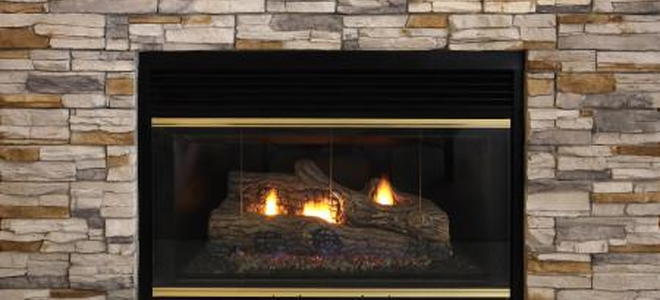
Choosing a fireplace is a personal decision. You have to decide which is best for you and your surroundings, and there are a lot of things to consider when making this choice. How much can you budget? What are the amenities you are looking for? Are you into "green" heating? Do you want an efficient fireplace to cut down your heat bill or do you want one just because you want one? Getting the answers to these questions will better prepare you for when it comes time to make your investment.
Electric Fireplaces
Electric fireplaces have really made a niche for themselves in the last several years. You see them on the shelves in many big box stores, and they are a “hot” commodity (pun intended).
Electric units have a lot going for them. They are energy efficient and do not release any pollution into the air. Some models work like a space heater but are much safer and have a nice, lifelike flame. They are safe for kids and pets; they are cool to the touch because the heating element is tucked inside the unit, while a blower forces the warmed air out into the room.
They have other amenities as well. For example, you can run the flame without the heat and vice versa. Some units have timers that can turn themselves on and off once the timer is set. Most electric units come with a remote control as well, and best of all, you can put them in any room in the house because they do not require a chimney. The only maintenance for an electric fireplace is an occasional vent dusting.
Gas Fireplaces
Gas fireplaces will provide a little more ambiance than an electric unit. The fire is real and works like a gas oven, with the burner hidden by ceramic logs that spread the fire and make it look like a real wood fire.
Gas fireplaces burn either natural or propane gas. They burn pretty clean but do produce some carbon monoxide, so they need a chimney. This is where the cost can increase. You must check the codes in your specific area but most chimneys will require professional installation. Once it is installed, there is of course no moving it to another room, so you must make sure the location is perfect.
Because there is a real flame, gas fireplaces do get very hot and can burn you or anything near the hearth. Even if there is a glass front on the unit, the glass will get very hot. Gas units also come with a blower and can push warm air into the room, but keep in mind that there is a chimney, so you will lose some heat to the outdoors. Some models can also come with a remote control.
Wood Fireplaces
Unless you are building a new home, adding a real wood fireplace is very costly. Like with a gas fireplace, a chimney must be built in addition to the fireplace itself. Even though the smell and sound of a real wood fire is tempting, investigate thoroughly before diving in and dropping cash.
Real wood fireplaces can let a substantial amount of the heat escape through the chimney and also suck out about 10% of the indoor air. There are fortunately ways to make a wood fireplace more efficient. You can have it insulated and add a fan heat exchanger and glass doors, but these add-ons will cost more. Then, besides the building and efficiency costs, there is an ongoing cost of purchasing wood to consider. A real wood fireplace is a significant investment in the long term.
There is also maintenance to take into account. Each time you want to start the fire, there is no simple switch like other models of fireplace. You will have to build the fire and be responsible for seeing it properly and safely put out. The ashes have to be cleaned out often, and wood fireplaces also require a thorough cleaning once a year (at least). A wood fireplace puts more pollution into the air than any other type of fireplace as well, but it offers the most ambiance with real smells and crackling sounds.
A fireplace is where everyone likes to congregate for warmth and family meetings. They are a place to feel safe and
secure, to entertain, and to warm the home. A fireplace will improve the value of your home, so consider what is most
important to you when deciding which is right for you and your family.
Troubleshooting Basic Problems of Gas Fireplaces
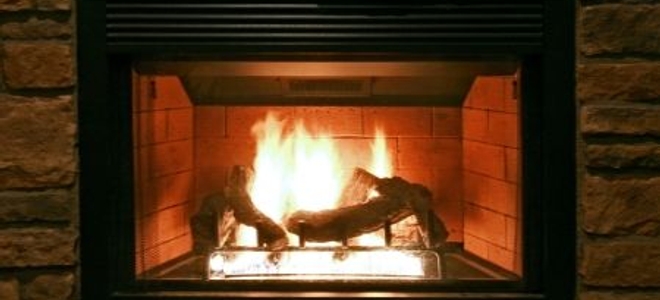
Gas fireplace repair can be daunting, depending on the problem that arises. One of the things that makes fixing a gas fireplace issue so difficult and complex is finding its source. There could be multiple factors causing a single issue, so covering all your bases and eliminating potential culprits can be time consuming and may require a level of expertise you may not have.
However, there are some basic issues that you can repair on your own without too much trouble. At the very least, this guide will help give you a better understanding of each problem so you can identify them more easily.
DISCLAIMER:
Working with gas and gas appliances is dangerous. If at any point, before, during or after your investigation or repairs, the area smells excessively of gas and you can not determine the cause, call an expert for help immediately.
Pilot Light
The pilot light for you gas fireplace, as it is for many gas appliances, is an ignition source. If your fireplace won't turn on, it may be a simple matter of the pilot flame having been blown out. In order to find out, simply open the vent and you will be able to determine whether or not the small flame is out. If it is, simply re-light the pilot with a match or a lighter and test to see if the fireplace turns back on.
Alternatively, if the flame reignites initially but the pilot won't stay on, there are more in depth factors to investigate surrounding the pilot light.
The Thermocouple
The thermocouple is a small metal rod that intersects the gas valve and the burning pilot flame. It acts as a temperature sensor and generates electricity to ignite the gas when needed.
Because it's so small and must interact with multiple other components, the condition, placement, and stability of the thermocouple can all impact your fireplace for the better or for the worse.
Thermocouple issues are usually simple fixes that boil down to them not being screwed in securely or just needing to be repoisitioned. While you are in position examining this piece, ensure that all of the wiring and tubing are correctly placed and functional.
The Thermopile
Similar to the thermocouple, a thermopile is a sensor that generates voltage. In newer model gas appliances, or anything else that has electronic gas control, thermopiles are used in place of thermocouples. Due to their place in electronically controlled gas fireplaces and the fact that this mechanism generates power measured in millivolts, they are also known as gas fireplace generators and millivolt generators.
Testing or replacing one of these should only be done after you've ruled out the other obvious culprits since it's a fairly complicated process.
Using it's generator function to check how much energy it's providing is a good way to figure out if your current wiring is adequate. Loose or inadequate wiring can be the root cause behind noticeable problems like a burner that is sluggish or won't come on at all.
Conclusion
While these three components of your gas fireplace system are commonly behind some of the larger performance problems your fireplace may experience, other issues such as needing a gas valve replacement, a gas leak, or some complex combination of all of the issues already listed require the intervention of a professional to get true answers.
Looking for a new fireplace, fireplace fender, accessories or more? Compare types, brands and prices with our Fireplaces Buyer's Guide.
Posted on
August 15, 2017
by
fabrizio zenone
Coquitlam resident Byron Vallis two weeks before the opening of his Mariner Brewing.
He's been pulling 100-hour weeks for the past four months and, now, Byron Vallis is finally ready to pull the tap handles at Coquitlam's first craft brewery.
A partner in Mariner Brewing with Wim Vander Zalm — Vallis' former employer at Art Knapp Plantland in Port Coquitlam — he's preparing for its grand opening on Aug. 22.
Five frosty possibilities will be on tap: a northeast India pale ale, a dry-hopped cream ale, a sour weisse, an amber ale and a Scottish ale.
"It's a really diverse lineup for opening day," the Dr. Charles Best secondary school grad said, "and we have so many more ideas. We already have the ingredients for a white IPA."
The beer ingredients are also west-coast sourced, Vallis said, with most of the hops supply imported from Oregon.
There's some local support, too — from his competition at the four breweries on Port Moody's popular Brewers Row. Vallis said their owners have been "really supportive. It's a surprise. But when new places open, everyone's on board because it's yet another craft beer for B.C."
Ahead of the opening, Mariner will be represented at Coquitlam's Kaleidoscope Festival on Saturday as well as the Aug. 19 Battle of the Brews, a fundraiser for the Surrey Fire Fighters Charitable Society.
In the meantime, Vallis and staff are preparing their 3,000-sq. ft. premises — including a 45-seat tap room — at H-1100 Lansdowne Dr. (across Barnet Highway from Milestones). "We've just been going non-stop to get everything in order."
A small patio at the front will open soon and, perhaps next season, a 30-seat patio out back, facing south toward the Evergreen Extension.
Posted on
August 1, 2017
by
fabrizio zenone
Have you recently tiled a bathroom floor? Or your shower pan? Or your whole shower? If so, you probably have a few – or a lot of – leftover tiles. These 13 DIY projects will put them to very, very good use. And if you haven't recently tackled an ambitious tiling project, don't worry: pick out your favorite DIY to try and head to your favorite home improvement store to buy the appropriate number of single tiles.
Gorgeous leftover Carrera marble tiles deserve a chance to shine on their own; backing each one with cut-to-size cork to create coasters lets them do just that. The juxtaposition of marble and cork is surprisingly appealing.
If you have a handful of little hexagon tiles leftover, this project is perfect for you, especially since you can easily adjust the dimensions based on how many tiles you have.
If your tile project left you with an entire box of unneeded tile, don't regret overbuying! It just means you have the opportunity to make a gorgeous table like this one.
Coordinate your fridge with your back-splash or floor by using leftover tiles to make sweet little magnets. This is a great way to showcase precious marble tiles, but it could do just as well with less prestigious tiles.
This is another great project if you just have a few tiles leftover, and it works no matter how many tiles you've got. Paint the board the same color as your tiles for a sleekly monochromatic look, add hooks, and hang away.
If your project leaves you with a sheet of tiles, roll it around a vase (a cheap number from the dollar store is perfect), fill in the spaces with grout, and voilà! Also, as this tutorial points out, this is a great, low-stakes way to get the hang of tiling without tackling a floor or wall.
This project makes it clear that you'll want to add glitter to the grout in all of these DIYs. Glitter grout! Spice up your favorite cheapo IKEA table with three (or more) different types of leftover tile and the sparkliest grout in the land. It's surprisingly subtle, but with no lack in attention to detail.
Use the leftover tiles from all of your tiling projects to create this graceful window frame—a great way to add character to a bare bones rental. And if you're not feeling super ambitious (or if you don't happen to own a jigsaw), simply use the tiling method described to mosaic an existing picture, mirror, or window frame.
This tutorial is proudly saw-free, meaning you won't have to rent (and use) a tile saw if you can arrange your tiles correctly. And while the instructions will teach you how to tile all sides of a kitchen island or peninsula, you can simply tile the top.
If you have some leftover glass and/or mirrored tiles, give them some copper tape borders and solder them together to create
candle holders in a variety of shapes and sizes. Bonus: These make great gifts, especially if you pop a little votive in them.
If your leftover tiles happen to be boring but you don't want them to go to waste, adorn them with photo, or even patterned scrapbook papers using Mod Podge. And if your leftover tiles happen to be actively ugly, cover them completely with photos printed the exact size of the tiles (or slightly larger, to cover the sides as well).
You could also spruce up plain tiles with Sharpie paint markers and use them to build a charming planter. If your drawing skills are excellent, show off by creating designs inspired by intricate Moroccan or Mexican tiles.
Posted on
August 1, 2017
by
fabrizio zenone
Local NDP candidate Selina Robinson speaks to a reporter after a campaign stop by Leader John Horgan in Coquitlam, B.C., on Sunday May 7, 2017. Robinson, British Columbia's new housing minister, says she is reviewing the tax on foreign buyers of Vancouver real estate and the province's interest-free loan program to first-time homebuyers.THE CANADIAN PRESS/Darryl Dyck - The Canadian Press, 2017
VANCOUVER — The British Columbia government is reviewing the foreign buyers' tax in the Vancouver area and the interest-free loan program to first-time homebuyers to determine whether they have helped improve affordability, the province's new housing minister says.
In an interview Monday, Selina Robinson said she and provincial Finance Minister Carole James will go over real estate transaction data in an effort to decide whether such measures should be kept, revised or scrapped altogether.
"I don't know that we have any plans to eliminate it," Robinson said of the 15 per cent foreign buyers' levy, nearly a year after the previous Liberal government introduced it for Metro Vancouver.
"There's certainly enough data that would help us to understand its value, and so, we have to look at that data."
Robinson said she understands the tax had some impact early on, but that is starting to slip away.
From June 10 until Aug. 1, 2016 — one day before the tax took effect — 13.2 per cent of all property transfer transactions in Metro Vancouver involved foreign buyers, according to data from the B.C. Finance Ministry. From Aug. 2, 2016, until the end of last year, that figure fell to 2.6 per cent.
In the months after the tax, there were signs of cooling in Vancouver's housing market, with the number of transactions falling. However, there have been signs that the market may be rebounding, as prices continue to creep up.
The Multiple Listing Service composite benchmark price for all properties in Metro Vancouver was $998,700 in June, an increase of 7.9 per cent from the same month last year, according to the Greater Vancouver Real Estate Board.
Tsur Somerville, the director of the University of British Columbia Centre for Urban Economics and Real Estate, said the tax may have dampened foreign interest in a city where housing prices are among the most expensive in North America.
But another possibility is that some foreign buyers are not self-identifying as such or have shifted to purchasing properties, such as presale condominiums, that aren't covered by the tax, he said.
The foreign buyers' tax was a contentious move that angered some groups and prompted a class-action lawsuit that is now awaiting a certification hearing in early November.
The claim's lead plaintiff is Jing Li, a Chinese citizen residing in Burnaby, B.C. Li found the $559,000 property she purchased in July would suddenly be subject to an additional $83,850 in taxes because the deal was to close after Aug. 2.
The proposed lawsuit alleges the tax is unconstitutional. But in the province's statement of defence filed in May, the government denies the tax is unconstitutional or violates the Canadian Charter of Rights and Freedom. The allegations have not been tested in court.
Robinson was unable to comment on whether her party would fight the action in court.
Before they won the May election, the NDP promised to bring in an annual two per cent tax on vacant properties, but Robinson said that too is under review.
Andrey Pavlov, a professor who specializes in real estate finance at Simon Fraser University in Burnaby, B.C., said he hopes the government implements policies that would ease development restrictions to increase housing supply.
"Unless we can increase supply, we can tax people at any rate we want," Pavlov said.
"It's not going to make any difference because we just don't have enough units."
Posted on
August 1, 2017
by
fabrizio zenone
Wondering if the time has come to move on? Here’s how you know
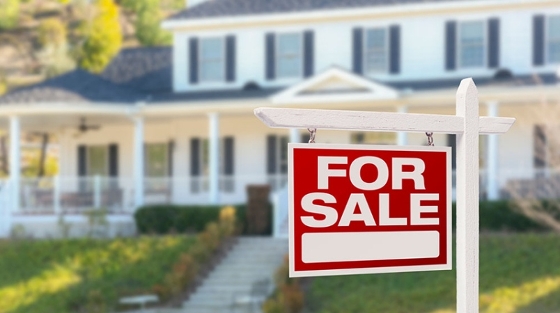
Have you been in your home for a long time? Wondering whether it’s time for a fresh start? This article provides a quick checklist of reasons that are not obvious, such as moving for work or personal reasons. Instead, we consider signs that can occur in everyday life to tell us it’s time to move on.
1. That bedroom is now a junk room
We all need room to store our sports equipment, off-seasons clothes or paper records of important information, and that room is called “storage”. It started as a quick fix, like “let me put the bike here for a sec,” and now it’s been sitting there for over a year. In some cases, a large cardboard box or even another bike made its way in. Keeping storage contained and organized is not an easy task, but is necessary.
2. When the grass is knee high and the gutters are collapsing
During the summer months, grass and plants grow very fast and it’s hard to keep up. The garden beds could get a little TLC by weeding and swapping out plants with new ones. While you're outside, look at the trim of the house. Is the paint chipped? When was the last time the gutters were cleaned up? At this point, your property starts to lose value. Maintaining and improving a property is a challenging task requiring funds, time, energy and creativity. It could be that this property is more house than you can handle. Have you ever wondered how a property becomes a teardown?
3. More for-sale signs than you would believe
Who are those new neighbours? They moved in a while back, but are strangers to you and the reverse is probably true. Breaking the ice with newcomers is just an acknowledgment as you cross paths on the sidewalk. It can be intimidating, but it’s not so hard. In the event you are not having the response expected, how does it make you feel? It’s a good idea to keep the pulse on the sale price of properties in the area in case it’s time for a change.
4. Local redevelopment applications are flourishing
“I remember when it was all fields!”Maybe not that extreme, but the landscape is changing and in Vancouver “densification”seems to be the answer to our housing crisis. New multi-family construction in your direct surroundings could impact:
●traffic, including parking;
●potentially your view;
●noise generation; and
●the amount of dust in the air.
If all that doesn’t appeal, maybe you can cash in on the activity and get out of the neighbourhood.
5. Your tenants are degrading the property
For those who rent out their home, consider selling if the security deposit won’t be enough to restore the property to its original state, and it won’t get any better. To actually make the property attractive to new tenants will cost you a fair amount of money. Does it make sense to make improvements that potential buyers probably won’t appreciate?
6 . You spend too long on your daily commute
Studies have concluded that a long commute slowly kills you. I find this conclusion a bit harsh, but the time, money and energy spent on the road can add up very quickly. Life happens and if you are driving simply everywhere, maybe it’s time to re-centre around at least one main activity, such as work, school, family or leisure activity.
7. Guests are not coming around anymore
It’s been awhile since your cousins or kids visited, and the guest room could use a paint job and a new mattress (Mum, this one is for you!). Oh, and the guest bathroom does not fully operate anymore.
8. You need a fresh start
A new home is a new start and an opportunity to become happier. What’s more, changing home helps declutter not only the closet but also the unnecessary automatic payments (for cable or the landline) you are not really using.
Lately, I’ve witnessed a new trend of lifelong friends moving closer to each other, and I must confess that I like the concept! As much as it can be a bit disarming to project such a major event as a move when you are not obliged to for work or personal reasons, it’s good practice to anticipate and seek out that next stage because nothing will prevent it from happening.
Here is a final tip for potential home sellers: It's a good idea to use the summer time to make your property picture-ready and take a few shots from different angles, at least from the outside. You never know what tomorrow brings and, in the event you need to list your property next March, you’ll be in a position to show your property in its best light.
Posted on
August 1, 2017
by
fabrizio zenone
Based on Your Income:
A general guideline is to allow no more than 30% of your gross monthly income (before deductions) to make your monthly housing payments. This test of your ability to repay a mortgage loan is generally referred to as the Gross Debt Service Ratio.
Complete the following calculation to determine the approximate amount you may be able to afford for the mortgage payment, the property taxes and, where applicable, 50% of the strata maintenance fees. Some lenders will require that this total maximum monthly payment also covers heating costs.
- Your gross monthly income $___
- Co-signor’s gross monthly income (if applicable) $_____
- Other income (monthly) $______
- Total monthly income $______
- Multiply the Total line above by 30% to calculate your: Total monthly maximum housing payment $______

Based on your Other Financial Obligations:
If you have other monthly financial obligations, such as car or credit card payments, the lending institution will also apply the Total Debt Service Ratio test to determine the maximum mortgage loan for which you can qualify.
$ ____ Your monthly housing payment
$ ____ Your calculated monthly debt payments (car, credit card, etc.)
$ ____ Total monthly payment
A general guideline should be that the total of your monthly housing payment added to your other monthly debt payments should not exceed 40% of your monthly gross income.
The Gross Debt Service Ratio and the Total Debt Service Ratio tests protect both you and the lender by ensuring that you do not take on more debt that you can reasonably afford to repay.
Many lending institutions will prequalify you for a specific size and type of mortgage loan before you begin searching for your new home. Taking the time to apply for a pre-approved mortgage will give you the security of knowing how much you can afford to spend.
Before concluding the loan agreement, most lending institutions will require an appraisal of your selected home. The appraised value is a professional opinion of the value of the home and may differ from the purchase price you are willing to pay. The appraised value may affect the approved value of the loan.
Posted on
July 17, 2017
by
fabrizio zenone
When Country Living's Style Director, Page Mullins, purchased a 1920s bungalow in Birmingham, AL, she knew it was in need of a total overhaul. Room by room, she is tackling the space and giving it a fresh face with a neutral, restrained palette.
"I am always finding new inspiration on CL photo shoots. I'm constantly bringing home new textiles and antiques finds from the road and changing up elements in my house," says Page, "so I knew I needed a classic, neutral backdrop at home to build and layer up on."
Here, she jumpstarts the process with a bedroom and bathroom makeover, plus shares what she's learned along the way.
Posted on
July 17, 2017
by
fabrizio zenone

Finding a Vancouver property that fits your lifestyle, location preferences and budget can be a tricky process. Buyers must know what to prioritize, what to budget for and what to put on the backburner when it comes to finding the right home.
Q: What is the best way for home shoppers to decide what type of home fits their lifestyle and what they’re looking for?
Shawn: Check out open houses. The key to finding out what best fits your lifestyle is seeing as much product as possible. Part of my job is taking clients on tours of not just homes, but of neighbourhoods that we think would meet their needs and wants. Maybe it’s outside of where they think they want to be. I show them different properties and neighbourhoods that they may not have explored or even thought of. That’s where open houses offer a lot of value. Typically, every weekend between 2 and 4pm. there are dozens of open houses that would fit in one’s criteria that they can go see. The more you see, the more you realize what you do or don’t like, and it might open up some other avenues that you might not have thought of.
Q: Should buyers with a more limited budget opt for a home more centrally located or a larger home further out?
Location, location, location. If you’re living in an area where the walk score is high, you’re close to work and can walk there, which can alleviate many everyday stresses. Having to get in your car for a long period of time twice a day, to come in and out of work, is an added stress. I think Vancouverites have to realize, and this is what Millennials have to figure out as well, is that condo living and raising a family in a condo is acceptable and highly probable. Looking at our parents living in big homes with big land is not necessarily a luxury that will be an option for us.
If you’re okay with the hustle and the bustle inside the city downtown, West Side, East Side, or close to the core of Vancouver, there’s definitely a lot going on. It’s a higher-paced city. If you are more interested in living a quieter lifestyle and owning a bigger piece of land, being out in the suburbs may be the right thing for you, but you have to be OK with a little bit of a longer commute to get into the city if that’s where you decide to work.
How I help people make that choice is to show them what you can get in different areas that you’re looking at, and take that drive during rush hour or outside of rush-hour times, just to get an idea of what to expect. They have to go through that experience to see what it’s going to be like.
Q: With a bigger budget, for example $2 million-plus, is it more valuable to invest in higher end property with no land (i.e. a condo) or investing in a detached house on a lot?
I’m a firm believer in buying land. There’s only so much land in Vancouver. You can always build up on a given piece of land, but you can’t build any more land than we have. Land is being densified, which is creating more scarcity. Every time you turn a piece of single family land into a duplex or into apartments, there’s less single family land.
Q: For first-time buyers, do you recommend buying a finished home or a fixer-upper that they can put their own sweat equity into?
I like the idea of starting with an unfinished product. You start small, get in the market, buy whatever you can, the building’s in good condition, you’re in a good location, and the inside is tired and needs some work. You slowly but surely build up the equity, what’s in the property, and you can climb up the real estate ladder faster that way than buying something new. That’s what I did when I first started.
Posted on
July 17, 2017
by
fabrizio zenone
Average sale price increases in every real estate board in the province in June
Sales may be down from last year’s record-breaking activity, but that doesn’t mean home prices across the province are falling, according to the latest figures from the British Columbia Real Estate Association (BCREA) released July 13.
The BCREA reported that 11,671 BC homes were sold on the Multiple Listing Service® (MLS®) in June, a fall of 9.6% from June last year, and down 5.9% compared with May’s surge.
However, the average MLS® sale price in BC was $725,778, up 4.4% from the same month last year, and rising on an annual basis in every one of the 11 BC real estate board areas.
“Although home sales remain well off the record pace set last year, demand is still quite robust," said Brendon Ogmundson, BCREA economist. "That demand is supported by a strong provincial economy and vigorous job growth.”
He added, “Supply remains a challenge, which means most areas are seeing tight market conditions and significant upward pressure on prices.”
The number of total active listings across the province was down 6.2% to 29,651 units compared with June 2016.
Chilliwack was the board to see the highest annual price growth, up 18.3% year over year, followed by Kootenay, Victoria and Vancouver Island. Greater Vancouver saw the lowest average price increase of the 11 BC boards, a rise of 2.7% since last June.
Sales activity painted a different picture – revealing that it is largely supply, rather than sales volumes, that dictates price points. Along with Greater Vancouver, where sales were down around 12% in June year over year, Chilliwack saw an 11% annual sales decrease. In both Vancouver Island and Victoria, where prices are climbing robustly, year-over-year transactions declined 13-14%.
Posted on
July 11, 2017
by
fabrizio zenone

The City of New Westminster is averaging more than 50 new building permits every month this year, on a pace to edge out the $189 million in permits issued in 2016, the 10th straight year the Royal City has topped $100 million in permit values.
As of the end of May, permit values had already eclipsed $144.5 million, and housing starts, at 612 units, were far ahead of the 339 starts in the same period last year.
“If the pace holds, [2017] will work out to a 12.7% increase from the previous year,” said Blair Fryer, communications and development manager for the city of 71,000 on the banks of the Fraser River.
There is little doubt the pace will hold up.
This month, New Westminster council approved zoning for the largest tower the city has ever seen: Bosa Development’s 53-storey condominium skyscraper.
The building is part of a project that will include a second 43-storey tower and a three-storey commercial building, all built on the New Westminster riverfront.
The anchor tower of Bosa’s Pier West would be the tallest building between Vancouver and Calgary if built today.
“We saw overwhelming support for a two-tower scheme that opened up the skylines, with a modest increase in height,” said Dan Diebolt, development manager at Bosa Development.
Bosa bought the 660 Quayside site from Larco Developments last August for $63 million, which works out to $79 per buildable square foot, according to Colliers International. (Today, this could be seen as a bargain price, considering a non-waterfront site on Duncan Street in New Westminster sold this spring at $89 per buildable square foot.)
Larco’s original development plan called for 1,000 housing units in five towers. Bosa’s bid scaled that back to three buildings and 665 homes, mostly tower condominiums with a total density of 4.52 floor space ratio. Bosa had to earn the variance that allowed the zoning to go an extra eight floors of prime waterfront condo space that is expected to pre-sell for north of $750 per square foot.
The new development will provide approximately two acres of additional park and public open space, including an extension to the Westminster Pier Park. Fryer said it will also update pedestrian and cyclist access to New Westminster’s waterfront, including completion of the esplanade that connects the entrance to Westminster Pier Park and the River Market, along with a 40-space child-care facility.
To keep River Market merchants and existing residents in the waterfront area on board, Bosa also agreed to use a type of pile driving aimed at minimizing noise and will delay the construction start to ensure parking is provided at a neighbouring site.
Construction is now expected to start in the spring of 2018. Completion of Phase 1 – the 53-storey tower – is scheduled for the fall of 2021; Phase 2 is projected to be finished in the fall of 2022.
Pier West will also include 80 public parking stalls, 932 parking stalls for the development, and new pedestrian connections between Westminster Pier Park, Fraser River Discovery Centre and River Market.
After more than a decade of breakneck growth, New Westminster has become sophisticated in matching amenities to new developments. The city, for instance, insisted that the Bosa towers be landmark additions to the skyline.
“The part that I am really high on is that these buildings are going to be iconic,” said longtime New Westminster councillor Bill Harper. “That was written right into the design. Iconic means they are going to stand out. They are going to be a symbol, if you like, of New Westminster. When people are on the river, in Surrey or driving across the Pattullo Bridge, those will be some of the major landmarks for our city.”
Mayor Jonathan Cote said the Bosa site has been the “missing link” on the riverfront.
He said one of the city’s biggest successes in the past decade has been connecting the waterfront with the community
Posted on
June 20, 2017
by
fabrizio zenone
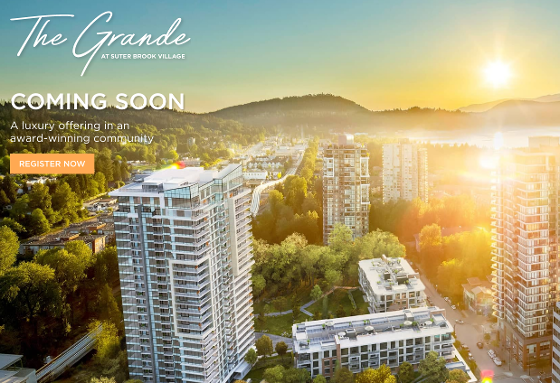
Proudly introducing The Grande by Onni. Ideally situated in Port Moody's award winning Suter Brook Village, this sophisticated 26-storey tower offers elegant 1, 2, and 3 bedroom homes. Enjoy the best of everything, with unparalleled amenities, designer interiors, and breathtaking mountain & ocean views. Don't miss your chance to be a part of Suter Brook Village.
URBAN LIVING
A vibrant social centre. A multi-cultural hub. There's something to be said for having everything you need right around the corner. Suter Brook Village is an all-encompassing neighbourhood situated on 22 acres of land in idyllic Port Moody, offering all of life's daily conveniences at your doorstep. You'll be connected to an energized community where urban elegance collides with natural West Coast beauty.
You can also travel with ease: just steps to the new Evergreen Line Inlet Centre Station, the West Coast Express, and minutes to highways in either direction, The Grande links residents to the rest of the Lower Mainland. Traveling to and from Suter Brook Village will be effortless, no matter which direction life takes you.
Posted on
June 20, 2017
by
fabrizio zenone
Wet soil and rainy days can wreck your landscaping if you don’t plan accordingly. Make the most out of your climate, and you’ll get a lot more out of your garden. Improve your soil and choose the right plants, and you’ll create a gorgeous landscaping design that will turn heads and stay beautiful even in the soggiest conditions.
Improve Conditions
Wet soil doesn’t have to put a damper on your gardening dreams. If the natural climate of your garden is wet, improve the conditions so plants can grow more easily in the soil.
Improve your soil, and it will support richer plant growth. If soil drains well, it can provide the right environment for plants even in a moist climate. Dig up your garden beds and turn the soil several times to aerate it. Add lots of organic matter (in the form of compost) to the soil to break it up and improve drainage. Compost will lighten up heavy, moist soil and keep it nutrient-rich to support healthy growth of plants.
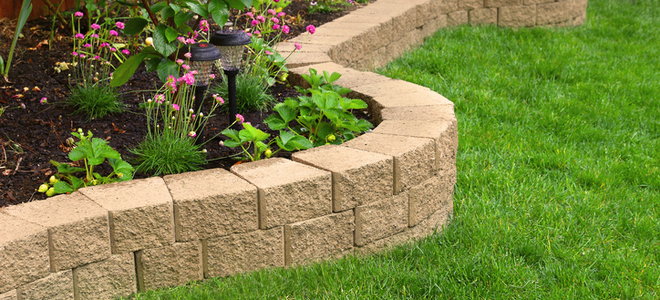
You can also use raised beds to keep garden soil well-drained and more hospitable to plants. If you live in wet conditions, elevated beds will drain better than regular garden beds in the ground, so soil stays dryer. Surround your raised bed with landscaping rocks, wood, or some other type of support, and build the soil up six to 12 inches higher than ground level. Be sure to include drainage holes around the base of your bed surround.
Choose the Right Plants
Pick the right plants for your garden, and wet soil will be your landscaping dream come true. There are many plants that thrive in moist conditions and look best when grown in wet soil. Use these moisture-loving plants to paint your landscaping with beautiful colors, and create a perfect look.
Flowering Shrubs

Hydrangea is a landscaping favorite, and it's a great choice for moist soil. This flowering plant loves wet soil, and blooms best when it has plenty of water. Hydrangea blossoms in soft shades of pink or blue, depending on the pH balance of your soil.
Black chokeberry is a great all-season plant for any landscaping design. These bushes produce pretty white flowers in spring. The foliage turns purple and red in fall, when the berries bloom.
Winterberry can grow in partial shade or full sun, so it's a versatile landscaping plant. Birds are attracted to the bright berries produced by this deciduous shrub, which adds another element of life and color to any garden.
Flowers

Marsh marigolds produce beautiful flowers in the early spring. The bright yellow flowers grow well in wet, swampy climates. Marsh marigolds will even survive and grow in standing water.
Canna flowers grow big, beautiful blossoms in bold red, yellow, orange, and pink shades. Cannas grow tall, up to eight feet in some varieties, to become a standout flower of any landscaping design.
Cardinal flowers are named for their bright red blooms. They'll grow well in watery gardens, and in full sun can get up to four feet in height. These flowers will also grow in partial shade, though they won't get as tall.
Groundcover

Lily of the valley is a pretty flowering groundcover that blooms with bell-shaped white flowers and dark green leaves. Lily of the valley likes moist soil best, and grows well in partial sun to full shade. Even in a rainy, overcast climate, lily of the valley thrives well and creates pretty white blooms.
Chameleon plant is a perfect wet weather groundcover. It grows well in moist soil and spreads out beautifully with colorful foliage. The leaves show shades of yellow, pink, and red around the edges, with deep green in the middle. Chameleon plant grows in full sun or partial shade.
Blue star creeper is named for its star-shaped, pale purple flowers. This groundcover is a gardening superstar that grows anywhere, from full sunlight to deep shade, so it can brighten up any corner of your garden. It loves moist soil and grows happily even in cloudy, overcast climates.
Posted on
June 20, 2017
by
fabrizio zenone
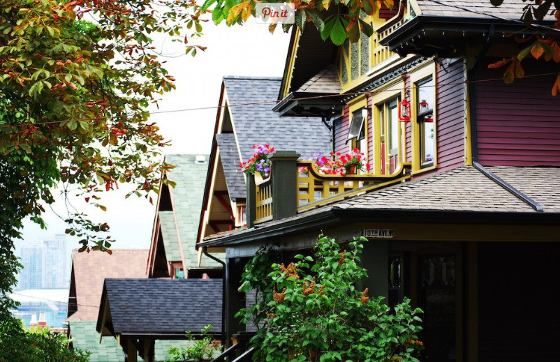
British Columbia’s foreign-homebuyer tax for Metro Vancouver was no panacea for massive price gains in the red-hot housing market, experts suggest.
“If it was damaging to begin with we would see significant drops in the prices of these homes,” Aaron Chen, president of local brokerage AISA Real Estate Services, tells BuzzBuzzNews.
“What it really did was to cause a lot of investors or homebuyers to step on the sideline, to see if the prices come down or not,” he adds.
Last year in July, Greater Vancouver home prices saw a 30-plus per cent year-over-year increase compared to 2015.
But when the tax was introduced in early August 2016, monthly price gains began waning, suggesting the tax was having a cooling effect on the market, at the time Canada’s hottest.
In fact, according to BMO Economics prices declined 4 per cent from their peak in the five months following the levy’s introduction, which came by way of a surprise announcement from the provincial government.
Commenting on Ontario’s recently implemented foreign-homebuyer tax, BMO Senior Economist Robert Kavcic addressed the limited effects of BC’s measure.
“While peak price growth might be behind us, the question is how much the market will cool from the unsustainable [30-per-cent-plus] pace, and how long will the adjustment persist?” Kavcic asks.
“If Vancouver is any guide, the answers appear to be somewhat and not too long, at least while interest rates are pegged at current levels,” writes Kavcic, answering his own query.
From January to April 2017, the benchmark price of a home in Metro Vancouver increased five percent to $941,000, says the Real Estate Board of Greater Vancouver (REBGV), showing resilience in the tax’s wake.
Part of that has to do with Vancouver’s global appeal, Chen says. Vancouver is considered a desirable city by many beyond Canada’s borders, so the AISA president suggests the foreign-buyer tax won’t deter overseas buyers from entering the market.
“In short, Vancouver is in high demand for the affluent, and when comparing prices from where they come from they feel, even at the prices today, it still seems like a bargain to them,” says Chen.
Last month, Greater Vancouver saw a 25.7 per cent decline in sales compared to April 2016 but sales were still running 4.8 per cent above the 10-year average for the month, says REBGV.
With continued demand striking the market, Chen says sales and home prices are predicted to continue on the upswing looking ahead.
“You will see more transaction volumes for sure and prices are definitely creeping up as we speak,” says Chen. “It may not move as fast as we had in the last three years but we’re very bullish with regards to the Vancouver market going forward,” he adds.
As demand rages on, supply levels on the resale side of the market are dwindling.
In April, Metro Vancouver had a total of 4,907 new listings, a decline of about 20 per cent from the same month last year, according to REBGV.
And with developers facing higher land costs in the area, Chen says costs are being passed down to homebuyers.
“The development site prices continue to rise like there’s no tomorrow, therefore driving up the cost to develop these sites. So as an end result they won’t be able to sell it for cheap,” says Chen.
“And developers are [building] because they sense the demand. That’s why they are willing to buy land at unprecedented prices continuously year after year in the City of Vancouver,” Chen adds.
While the Vancouver market bounced back, Chen still doubts the rate of growth moving forward will match last year’s record-breaking performance.
“Assuming the political positions don’t change I don’t think we’re going to see what we’ve witnessed last year moving onwards,” says Chen.
Posted on
June 13, 2017
by
fabrizio zenone
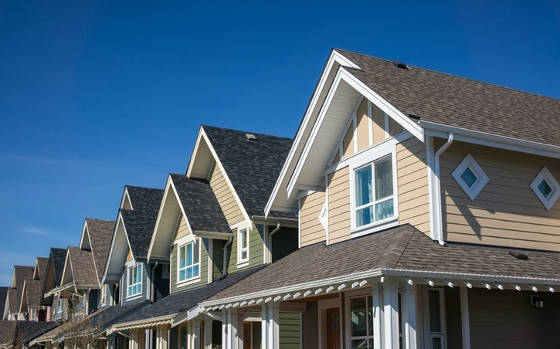
For the third year in a row, British Columbia will be Canada’s bright spot in terms of economic growth this year, according to RBC’s quarterly economic outlook report released June 12.
B.C. will see its economy grow 3% in 2017, RBC said, which is higher than the Canadian average of 2.6% and up from the 1.9% previously forecast for the province in the bank’s last quarterly report. RBC said the reason for the more optimistic outlook is that not only has B.C.’s economy shown little evidence of a slowdown despite the 40% downturn in Vancouver’s housing market last year, but it appears that downturn has run its course.
“Our view now is that the market will continue to recover gradually through the remainder of the year,” RBC said in the report. “This means that we no longer expect the housing sector to weigh on economic growth as much as we thought previously.
“Still, we see clouds forming over the B.C. housing market again next year when we anticipate interest rates beginning to rise.”
Because of this uncertainty for housing due to the possibility of a rate hike, B.C.’s economic growth is expected to moderate to 1.8% in 2018, which is lower than the average forecast growth for all of Canada next year of 2.1%.
A risk to the B.C. economy this year is the fact that the coalition government between the NDP and Green parties spells uncertainty for two huge projects in the province: the $8.3 billion Site C dam and the $7.4 billion Trans Mountain pipeline expansion. The GreeNDP partnership has already stated it plans to ask for further regulatory review of Site C and that it will use “every tool available” to block Trans Mountain.
As well, uncertainty in the softwood lumber conflict with the United States poses a very real threat to forestry-dependent communities in the province.
Strengths in the B.C. economy include a strong labour market – employment growth of 3.6% is forecast – and sales for provincial retailers, wholesalers, restaurants and manufacturers.
Alberta is expected to come in in second place with 2.9% growth this year, followed by Ontario at 2.7%
Posted on
June 13, 2017
by
fabrizio zenone
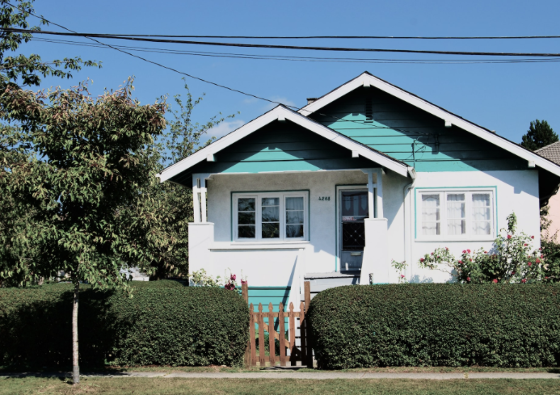
Vancouver real estate is seeing higher prices, especially detached homes where they’re now trading at June 2016’s scorching levels.
After taking a small dip last year, Vancouver real estate is back with a vengeance. The Real Estate Board of Greater Vancouver’s (REBGV) latest numbers showed detached home sales, the most expensive type of homes, saw prices increase for a third month in a row. The increase comes with higher inventory, and less sales.
Detached Prices Are Up
The price of a detached home is increasing across the REBGV. The benchmark price, that is the price of a typical detached unit, is now $1,561,000. This is a 3.1% increase from the same time last year, and a 2.1% increase from the month before. The benchmark is showing solid improvement, but it might not look like much when compared to last year’s massive 36.9% increase. This puts the benchmark price on par with June 2016.
Vancouver Detached Prices (Benchmark)DetachedPricesDecember 2015February 2016April 2016June 2016August 2016October 2016December 2016February 2017April 2017$1,200,000$1,300,000$1,400,000$1,500,000$1,600,000Canadian Dollars
| Month | Detached Prices |
|---|
| December 2015 |
1,248,600 |
| January 2016 |
1,273,100 |
| February 2016 |
1,305,600 |
| March 2016 |
1,342,500 |
| April 2016 |
1,403,200 |
| May 2016 |
1,513,800 |
| June 2016 |
1,561,500 |
| July 2016 |
1,578,300 |
| August 2016 |
1,577,300 |
| September 2016 |
1,567,500 |
| October 2016 |
1,545,800 |
| November 2016 |
1,511,100 |
| December 2016 |
1,483,500 |
| January 2017 |
1,474,800 |
| February 2017 |
1,474,200 |
| March 2017 |
1,489,400 |
| April 2017 |
1,516,500 |
| May 2017 |
1,561,000 |
Source: REBGV.
There’s been much talk about average prices falling, and that appears to be a reversing trend too. The average price of a detached sale in May 2017 went for $1,830,956, a 4.96% increase from the same time last year. For a little context, May 2016 saw the average detached sale increase in price 23%. Anyway you measure it, Vancouver detached homes are rising in prices. This doesn’t mean some of the nosebleed priced units will move at ask, but it means there will definitely be less deals to be found.
Listings Are Higher
Detached inventory across the Greater Vancouver Region (GVR) is building. REBGV logged 8,168 listings, a 5.7% increase from the same time last year. REBGV has attributed many of the listings to downsizing Boomers, looking to realize some of their profits. There’s also mounting evidence that overseas buyers liquidating assets due to capital constraints might be adding to the inventory.
Vancouver Detached Sales Vs. ListingsSalesListingsDecember 2015February 2016April 2016June 2016August 2016October 2016December 2016February 2017April 201707501,5002,2503,000Detached Homes
| Month | Sales | Listings |
|---|
| December 2015 |
1,136 |
830 |
| January 2016 |
1,047 |
1,929 |
| February 2016 |
1,778 |
2,811 |
| March 2016 |
2,135 |
2,931 |
| April 2016 |
1,979 |
2,883 |
| May 2016 |
1,865 |
2,915 |
| June 2016 |
1,920 |
2,618 |
| July 2016 |
1,077 |
2,386 |
| August 2016 |
715 |
1,814 |
| September 2016 |
666 |
2,147 |
| October 2016 |
652 |
1,596 |
| November 2016 |
638 |
1,205 |
| December 2016 |
541 |
513 |
| January 2017 |
444 |
1,915 |
| February 2017 |
741 |
1,430 |
| March 2017 |
1,150 |
1,924 |
| April 2017 |
1,204 |
2,091 |
| May 2017 |
1,548 |
2,657 |
Source: REBGV.
Sales Are Down
An increase in inventory can be a good thing, or a bad thing – depending on how sales respond to the number. REBGV saw 1,548 sales, a 17% decline from the same time last year. This leads to a much lower absorption of listings when compared to last year, but would be strong when compared to any other city.
An increase in inventory with a decline in sales typically leads to lower prices, but Vancouver residents didn’t get that memo. Despite the greater selection available for buyers, prices are still on the rise. Much of this has to do with multiple segments of buyers turning towards the same type of home. In order for those well funded Boomers to downsize and realize profits, they’re going to be competing with first-time buyers – placing even more pressure on prices.
Posted on
June 3, 2017
by
fabrizio zenone

If there is one part of the home buying process that all of Toronto hates – it’s when you have to compete for a home against other buyers.
That’s because in Ontario, buyers compete against each other in what is effectively a blind auction. Buyers only know the number of other buyers they’re competing against, not the details of the other offers. And it’s this lack of transparency that makes the process more stressful - and ripe for unethical behaviour.
Seller (listing) agents often ask buyers to improve their offer, claiming that two offers are “very close”. This leaves buyers wondering if there really is another offer that is close to theirs, or even another offer at all, a problem known as “phantom offers”, and whether the seller agent is dishonestly trying to get buyers to compete against themselves.
To guard against this, the Real Estate Council of Ontario (RECO) – the self-governing body that regulates Ontario’s real estate industry (8 out of 11 board members are real estate agents and/or brokers) started requiring seller agents to retain offer summary documents which have the buyers name and how long the offer is valid for (but not the price of that offer) as of July 2015.
But for every step RECO appears to take forward, they take a suspicious step or two backward - as in the astonishing case of the ‘escalation clause’ which has just made the bidding process even less transparent and worse.
A few weeks ago, one of my agents asked me about a discussion that agents on Facebook were having about using a clause that to date hasn’t been much used in Toronto and GTA - an escalation clause.
Here’s how an escalation clause works. Suppose you’re a buyer and you offer $800,000 for a home, but you really love the house and don’t want to lose it under any circumstances. Your agent might suggest you include an escalation clause which effectively says if there is another offer better than yours, you’re willing to pay $5,000 more than the top offer - without even knowing what the top offer is. Escalation clauses can have a cap on them limiting how much a buyer would pay but agents do make them with no limit on price.
There are a number of problems with escalation clauses. Firstly, seller agents who agree to entertain these types of clauses from a buyer would in effect be violating the RECO obligation to keep all the details of the other buyer offers including price private.
Consider this scenario. Suppose you make an offer on a home for $600,000 and are competing against one other buyer. The seller agent is not allowed to show the second buyer your $600,000 offer and ask them if they’re willing to beat it because the terms of your offer are supposed to be confidential. But suppose the second buyer offered $550K but included an escalation clause that states they’ll beat any other offer by $2,000. When the second buyer is told they won the house at $602,000, they have effectively been told the price you offered - without the seller agent actually telling them. The escalation clause is a work around the privacy rule.
This is why I confidently told my agent that she could not even entertain using (or accepting) such a clause. I had to eat crow two days ago on May 31 2017 when RECO’s newly released educational bulletin walked agents through on how to use an escalation clause.
And this is why I have become more convinced that self-regulating real estate is a bad idea.
Leaving aside the issue of privacy, let’s explore the bigger problem with escalation clauses which is that they make the risks of the blind auction, which already features perverse incentives that may tempt an unethical agent to cheat, even stronger - to phantom offers, RECO has just added the heightened risk of phantom prices.
In a best case scenario, the escalation clause is a work around the privacy rule, as we have seen. But in a worst case scenario, when the seller's agent is less than honest, escalation clauses act like a blank cheque that the seller and their agent can fill in as they please.
Even if buyer Jane includes a cap or maximum price in her escalation clause, the seller agent can push Jane to her maximum price because Jane has to take their word for it - there is no obligation for the seller's agent to retain a copy of the competing offer (and recall that the “Offer Summary Document” does not require the recording of offer price information).
These clauses help sellers and real estate agents by pushing up home prices higher than is necessary, but at the expense of all home buyers.
And RECO’s direction to agents, which does not outlaw the use of these clauses, but tries to regulate them (i.e., make them marginally less bad), continues to demonstrate that it is an organization run by realtors designed to protect and promote the rights and interests of real estate agents – not consumers.
As the Ontario Liberal government deliberates changes to the Real Estate and Business Broker’s Act to further protect consumers – the number one item on their agenda should be to end the real estate industry’s right to regulate themselves because it comes at the expense of the rights of consumers.
Posted on
June 3, 2017
by
fabrizio zenone
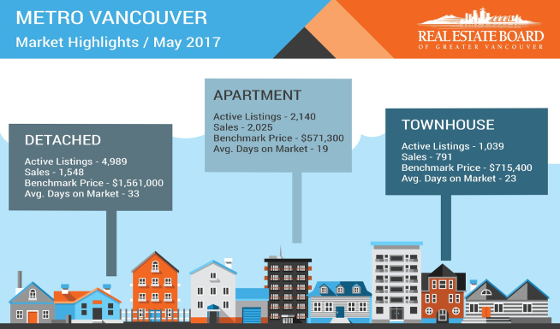
Home buyer activity returned to near record levels across the Metro Vancouver* housing market in May.
Residential property sales in the region totalled 4,364 in May 2017, a decrease of 8.5 per cent from the 4,769 sales in May 2016, an all-time record, and an increase of 22.8 per cent compared to April 2017 when 3,553 homes sold.
Last month’s sales were 23.7 per cent above the 10-year May sales average and is the thirdhighest selling May on record.
"Demand for condominiums and townhomes is driving today’s activity," Jill Oudil, Real Estate Board of Greater Vancouver (REBGV) president said. “First-time buyers and people looking to downsize from their single-family homes are both competing for these two types of housing.”
New listings for detached, attached and apartment properties in Metro Vancouver totalled 6,044 in May 2017. This represents a 3.9 per cent decrease compared to the 6,289 units listed in May 2016 and a 23.2 per cent increase compared to April 2017 when 4,907 homes were listed.
The month-over-month increase in new listings was led by detached homes at 27.1 per cent, followed by apartments at 22.7 per cent and townhomes at 14.1 per cent.
The total number of properties currently listed for sale on the MLS® system in Metro Vancouver is 8,168, a 5.7 per cent increase compared to May 2016 (7,726) and a 4.5 per cent increase compared to April 2017 (7,813).
"Home buyers are beginning to have more selection to choose from in the detached market, but the number of condominiums for sale continues to decline," Oudil said.
The sales-to-active listings ratio across all residential categories is 53.4 per cent. By property type, the ratio is 31 per cent for detached homes, 76.1 per cent for townhomes, and 94.6 per cent for condominiums.
Generally, analysts say that downward pressure on home prices occurs when the ratio dips below the 12 per cent mark for a sustained period, while home prices often experience upward pressure when it surpasses 20 per cent over several months.
“While sales are inching closer to the record-breaking pace of 2016, the market itself looks different. Sales last year were driven by demand for single-family homes. This year, it's clear that townhomes and condominiums are leading the way,” said Oudil. “It’s important to work with your local REALTOR® to understand the different factors affecting the market today.”
The MLS® Home Price Index composite benchmark price for all residential properties in Metro Vancouver is currently $967,500. This represents an 8.8 per cent increase over May 2016 and a 2.8 per cent increase compared to April 2017.
Sales of detached properties in May 2017 reached 1,548, a decrease of 17 per cent from the 1,865 detached sales recorded in May 2016. The benchmark price for a detached property is $1,561,000. This represents a 3.1 per cent increase over May 2016 and a 2.9 per cent increase compared to April 2017.
Sales of apartment properties reached 2,025 in May 2017, a decrease of 5.8 per cent compared to the 2,150 sales in May 2016.The benchmark price for an apartment property is $571,300. This represents a 17.8 per cent increase over May 2016 and a 3.1 per cent increase compared to April 2017.
Attached property sales in May 2017 totalled 791, an increase of 4.9 per cent compared to the 754 sales in May 2016. The benchmark price for an attached property is $715,400. This represents a 13.1 per cent increase over May 2016 and a 1.9 per cent increase compared to April 2017.
Posted on
May 29, 2017
by
Fabrizio Zenone
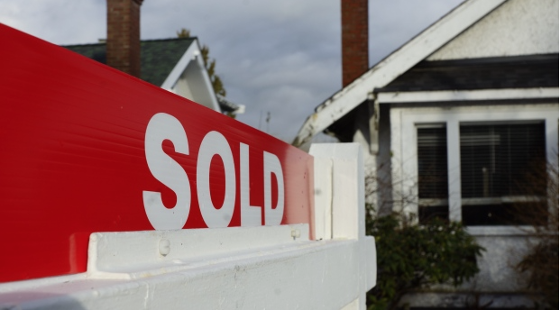
The Tri-City real estate market may not be seeing the same level of activity it did last year but prices are continuing to increase in all three municipalities, recent sales data shows.
In the last three months, according to a press release from the Real Estate Board of Greater Vancouver (REBGV) the median benchmark price in Coquitlam has increased 8.1% to $791,000 while Port Coquitlam’s went up 8.2% to $618,600 and Port Moody’s rose 5.1% to $805,400.
The largest median benchmark price increases have come for multi-family homes.
Townhouses in Coquitlam saw a three-month increase of 9.9% to $554,500 while apartments have jumped 10.1% to $383,300.
In Port Coquitlam, the price of an apartment jumped 8.9% to $334,900 while Port Moody saw a 7.7% increase to $531,300.
The figures reflect a wider trend across Metro Vancouver.
According to REBGV, residential property sales in the region for April totalled 3,553, a 25.7% decline from the same month last year and roughly in line with the 3,579 transactions that took place in March 2017.
Real estate board president Jill Oudil said in the first four months of the year, condo and townhouse sales have made up a larger percentage of all sales activity in Metro Vancouver.
“Our overall market is operating below the record-setting pace from a year ago and is in line with historical spring levels,” she said in a press release. “It’s a different story in our condominium and townhouse markets. Demand has been increasing for months and supply is not keeping pace. This dynamic is causing prices to increase and making multiple offer scenarios the norm.”
|
 BC historical rent increases.
BC historical rent increases.






























































